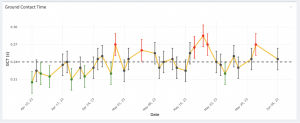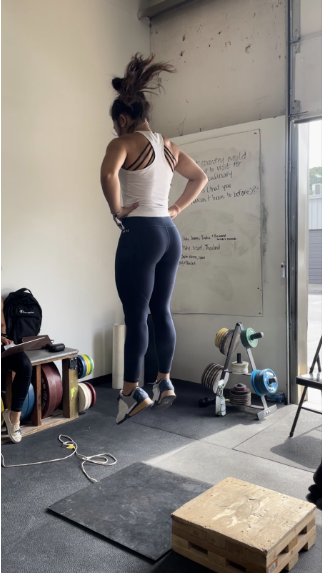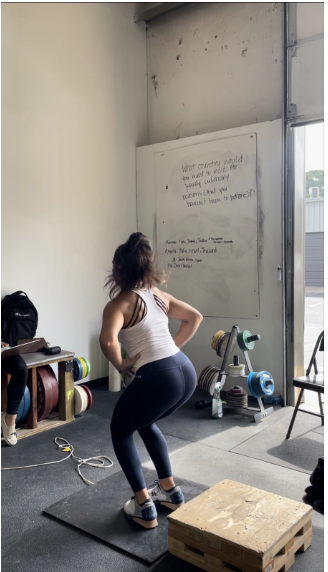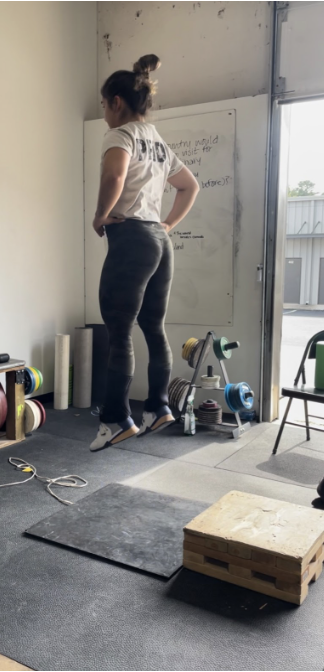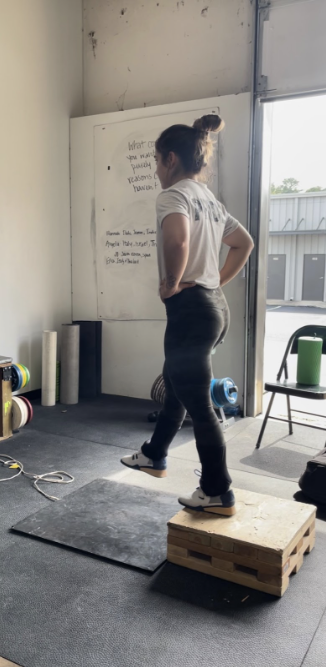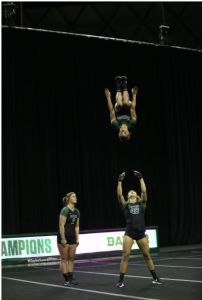“Pack it up, pack it in, let me begin…”
On any given afternoon, our HQ athletes shuffle in, diligently write down their training plan for the day (invaluable mental preparation when you have heavy cluster sets of squats ahead of you), and complete various prehab, activation, and dynamic stretching exercises that allow them to feel more or less ready. Before they even touch the bar, however, they gotta jump.
The vertical jump has been shown to have mechanical similarities to weightlifting movements (Carlock et al., 2004) and has also been used as neuromuscular fatigue monitoring for many different individual as well as team sports (Mercer et al., 2021). Daily measurement of the countermovement jump (CMJ) allows coaches a better understanding of the athlete’s neuromuscular status, i.e. the “acute responses and chronic adaptations to training and competition.” Simply put, it clues us into how a particular athlete is recovering from a particular stimulus. Are her jumps indicative of greater fatigue during a higher volume phase, as we would expect? Is he recovering from a deload week along our anticipated timeline? And if not, are there outside factors affecting performance that we are unaware of (e.g., adequate nutrition, sleep, work/life stress)? Is she nearing supercompensation? Fluctuations in physical performance happen both as a result of very precise planning and sometimes just life throwing a whole lot of lemons. Thus, our goal in athlete monitoring is ultimately to decrease the uncertainty around a coach’s decision-making and allow for some flexibility when the nervous system is primed for it.
Initially, it seemed like the last thing any of HQ athletes wanted to do was jump. So, we developed a simple and efficient jump mat protocol that allows us a real-time glimpse into what their acute fatigue might look like on any given day (what we refer to as “daily readiness”). Tracking that acute fatigue over time, however, is the real crux of our current sports science program. With the accumulation of jump data, we’ve been able to compare any given jump with the athlete’s baseline. From there, we can infer a multitude of things–whether that’s confirming if the athlete has been given enough of a stimulus, if the given stimulus is having the effect we want, if the athlete is recovering along the timeline we’d expect from a specific stimulus, if today is optimal for pushing intensity, or maybe the exact opposite. Any seasoned coach may tell you that he or she can discern all that just by looking at a few warm-up sets; and while that may be true, it’s also been extremely helpful to have the data to either back up our expectations for the training session or completely prove us wrong. At the end of the day, all of our sport science and data analyses are meant to be complementary to our coaches’ expert eyes.
We’ve purposely kept the protocol fairly simple so that it does not take up too much time or energy for the athlete (look out for part two detailing our specific jump mat protocol!) From there we calculate the reactive strength index (RSI) through the measurement of ground contact time (GCT) and jump height (JH), both of which are meant to emulate “various physical and sport performance tasks such as sprint acceleration, and cutting steps [e.g.,] change of direction (COD)” (Jarvis et al., 2021). In fact, according to that same literature review, isometric strength, isotonic strength, acceleration, top speed, and COD speed were all found to be significantly associated with RSI.
Weightlifting performance relies tremendously on the athlete’s leg and hip strength, important variables for generating maximal ground reaction forces in a short period of time (Travis et al., 2018). It follows that reactive strength would be an incredibly important metric of a weightlifter’s performance, as it demonstrates the athlete’s ability to rapidly change from an eccentric to concentric contraction–in other words, how well does the athlete utilize the stretch-shortening cycle (SSC). Since tendons are the primary site for storing elastic energy, the DJ test allows us to gauge the ability of the weightlifter’s “tendons and muscles…to store and release elastic energy when exposed to high stretching forces such as those found within jump landings” (Ball & Zanetti, 2012), i.e., catching a snatch or clean. Research further shows that acute fatigue presents as changes in GCT, RSI, and control of muscle-tendon stiffness for jump-based exercises (Comyns et al., 2011). Thus, tracking RSI as a direct expression of the athlete’s “dynamic explosive vertical jump capacity” (Walker, 2016) has been an extremely useful tool in gauging the athlete’s explosive predisposition for that training day.
We have the opportunity to work with some pretty gifted and explosive athletes, with varying athletic backgrounds. That being said, any given athlete can display an impressive RSI, leading us to believe that they’re primed to max out their assigned complex–but what if they don’t? More often than not, technical acumen supersedes an athlete’s explosive capacity (‘At some point, you just need to try’ – thank you, Spencer Arnold). There are many lessons to be learned through failure, and in this instance we as coaches are given more information or data, if you will, to put towards designing a better program for the specific athlete. Collecting CMJ and RSI is all well and good, but will never be a replacement for actual coaching expertise; thus our primary goal in collecting all this data is to elucidate some of the gray areas in program design in order for our coaches to make more well-informed decisions.
What we know to be true in weightlifting (as in any sport): monitoring and assessing an athlete’s ability to recover is absolutely essential. And yet, physical and mental resilience is far more complex than we could ever imagine.
✌🏽
Angela Skarpelis
References
Ball, N. B., & Zanetti, S. (2012). Relationship between reactive strength variables in horizontal and vertical drop jumps. Journal of Strength and Conditioning Research, 26(5), 1407–1412. https://doi.org/10.1519/jsc.0b013e3182510870
Carlock, J. M., Smith, S. L., Hartman, M. J., Morris, R. T., Ciroslan, D. A., Pierce, K. C., Newton, R. U., Harman, E. A., Sands, W. A., & Stone, M. H. (2004). The relationship between vertical jump power estimates and weightlifting ability: A field-test approach. Journal of Strength and Conditioning Research, 18(3), 534–539. https://doi.org/10.1519/00124278-200408000-00025
Comyns, T. M., Harrison, A. J., & Hennessy, L. K. (2011). An investigation into the recovery process of a maximum stretch-shortening cycle fatigue protocol on drop and rebound jumps. Journal of Strength and Conditioning Research, 25(8), 2177–2184. https://doi.org/10.1519/jsc.0b013e3181e85b6a
Jarvis, P., Turner, A., Read, P., & Bishop, C. (2021). Reactive strength index and its associations with measures of physical and sports performance: A systematic review with meta-analysis. Sports Medicine, 52(2), 301–330. https://doi.org/10.1007/s40279-021-01566-y
Mercer, R. A. J., Russell, J. L., McGuigan, L. C., Coutts, A. J., Strack, D. S., & McLean, B. D. (2021). Finding the signal in the noise—interday reliability and seasonal sensitivity of 84 countermovement jump variables in professional basketball players. Journal of Strength and Conditioning Research, 37(2), 394–402. https://doi.org/10.1519/jsc.0000000000004182
Travis, S., Goodin, J., Beckham, G., & Bazyler, C. (2018). Identifying a test to monitor weightlifting performance in competitive male and female weightlifters. Sports, 6(2), 46. https://doi.org/10.3390/sports6020046
Walker, O. (2016, July 31). Reactive Strength Index. Science for Sport. https://www.scienceforsport.com/reactive-strength-index/


